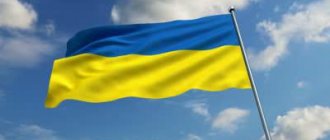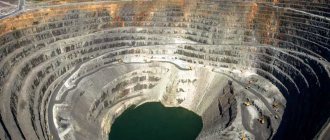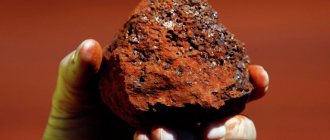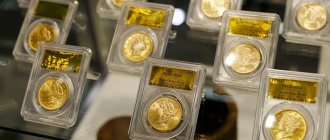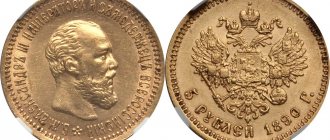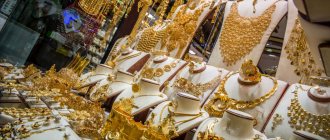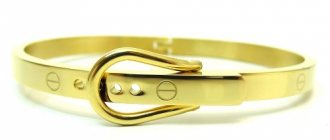What are gold and foreign exchange reserves and why are they needed?
Every modern state is called upon to protect its citizens - and this applies not only to the army and police, social protection is also important. Particularly advanced states create special reserve funds in order to prevent a decline in the incomes of the most vulnerable segments of the population in the future (examples - Norway, Russia). But any state also has “eternal values” in reserve - first of all, gold and savings in a stable currency.
All this is usually called gold and foreign exchange reserves, which are needed to smooth out macroeconomic fluctuations
. In other words, if a country imports more goods than it exports, it needs to cover the difference from something. And if the world market is “stormy,” then reserves can be used to mitigate the consequences of the crisis.
That is, gold and foreign currency reserves are not an analogue of the reserve fund (although in Russia the Reserve Fund was part of the gold and foreign currency reserves), but all highly liquid assets that the state has at its disposal.
Gold and foreign exchange reserves are made up of several components:
- funds in foreign currency. In addition to currency in cash, these are balances on correspondent accounts, deposits with maturities of up to a year, debt securities with non-resident issuers, etc. That is, this is the currency itself and everything that can be quickly converted into it;
- special drawing rights and reserve position in the IMF. This is, respectively, the country's debt to the IMF and the IMF's debt to the country;
- monetary gold. It must be made in the form of ingots of a purity of at least 995/1000. Gold does not even have to be located in the country - it can be stored abroad.
During the Bretton Woods system and the gold standard
The world has moved from saving exclusively in gold to dollars. This was possible because the United States pledged to keep the exchange rate at $35 per ounce. The system existed since 1944, but already in 1968 a double gold market appeared (where the price depends on supply and demand), and in 1971 the gold standard was abolished. The dollar is gradually devaluing against gold, but even within the framework of the current Jamaican system, the American currency continues to dominate in international payments, so states still hold reserves mainly in dollars and monetary gold.
Gold and foreign exchange reserves are needed to, if necessary, stabilize the balance of payments and the exchange rate of the national currency, issue loans to other states, ensure international payments, and simply have a reserve of liquid funds in case of the next crisis (when it will be necessary to cover the budget deficit).
Gold reserves can grow due to various reasons
- for example, a country can mine gold (which is also the case in Russia), the state represented by the Central Bank can actively buy it, as well as dollars (if the trade balance is positive), the Ministry of Finance can issue international debt securities and sell them, etc. . And in 2020, the gold reserves of many countries increased simply because the price of gold on the world market has risen significantly.
Regarding the form of gold and foreign currency reserves
, then most of them are securities and account records (usually virtual). But there is also a certain part of gold that is stored in Gokhran and the Central Vault of the Bank of Russia.
How Russia's international reserves have changed
In August 2021, news appeared in all media that Russia’s international reserves had grown to a record $600.7 billion
- this is a little, but still more than the previous record of 598.1 billion, set in August 2008. On the one hand, the sharp increase in reserves during the crisis looks quite strange, but everything falls into place if we remember how gold prices have increased.
At the same time, “physically” the volume of reserves became even smaller - due to the severe “coronavirus” crisis, the Central Bank was forced to sell currency and some assets in order to stabilize the financial market. But the revaluation of assets due to rising quotes covered this.
If you look at the graph of international reserves since 1998 (when the Central Bank began publishing data), two periods of decline are clearly visible
– this is the crisis of 2008-2009 and 2014-2015:
Currently, Russia's international reserves are at a level near a historical maximum.
, but it’s worth understanding that gold will lose a little in price over time, ceasing to be the only protective asset for investors, and the volume of Russia’s reserves will decrease.
However, it can be seen how the volume of reserves has increased tenfold since the 90s. Of course, the rise in oil prices played a certain role in this, which made it possible to direct the “surplus” to the Stabilization Fund, which was then divided into the Reserve Fund and the National Welfare Fund (since 2018, only the National Welfare Fund remained). In addition, it is believed that the growth of gold and foreign currency reserves was helped by the fact that the authorities gradually brought order to the gold mining sector - before that, part of the precious metal flowed abroad without any accounting in Russia.
As for periods of recession, they are associated with the negative background of the global financial market (2008) or with the depreciation of Russian assets due to the devaluation of the ruble
(2014-2015). At the same time, as can be seen, the next wave of devaluation in 2020 did not affect the volume of international reserves.
By the way, back in 2015, the Central Bank set an ambitious goal - to increase reserves to $500 billion (at that time they were less than 400 billion), but already in 2018 the goal was recognized as irrelevant. Then it became clear that the volume of reserves would grow even more.
In recent years, the Ministry of Finance and the Central Bank have been gradually moving away from using the dollar.
as a reserve currency - for example, a year ago the euro in the gold and foreign exchange structure was larger than the dollar, and there was quite a lot of Chinese yuan. However, then the interest rate on the euro fell to negative values, and the yuan was devalued due to the US trade war with China. But, nevertheless, there is still a trend towards reducing dependence on the dollar.
Structure
According to its structure, the Russian gold reserve is divided into two main parts:
- stored in the Bank of Russia, the decision on spending of which is made by the Bank of Russia in the manner agreed with the Government of Russia;
- located in the State Fund of Precious Metals and Precious Stones of the Russian Federation[8], decisions on the replenishment and expenditure of which are made by the President and the Government of the Russian Federation[9].
Analysis of structure and related assets
| date | Total weight of ZRR[10] (t) | Part of the monetary [5] Bank of Russia in ZRR (t) | Part of the monetary Au of the State Fund [11] in ZRR (t) | Mass of non-monetary Au (not included in the RRR) of the Bank of Russia (t) | Total amount of monetary and non-monetary Au (assets in Au) of the Bank of Russia (t) | Total value of precious metals of the Bank of Russia (billion rubles / US dollars) | Cost of precious metals of the Bank of Russia without Au (billion rubles / US dollars) | Total weight of ZRR and non-monetary Au Bank of Russia (t) |
| 01.01.2014 | 1035,75[12] | 1012,6[13] | (23,15)[14] | 78,5[15] | 1091,1[13] | 1394,150[16] / 42,6885[17] | 17,642[18][19] / 0,5402[17] | 1114,25[20] |
| 01.01.2013 | 957,99[21] | 932,8[13] | (25,19)[14] | 78,3[15] | 1011,1[13] | 1646,187[22] / 54,1996[17] | 9,661[18][23] / 0,3181[17] | 1036,29[20] |
Current state of Russian reserves
So, Russia's international reserves consist of gold and foreign currency (including equivalents). And, although gold is one of the most reliable types of assets, currency still prevails in the structure of reserves:
At the same time, foreign exchange reserves consist almost entirely of foreign currency.
, SDRs and the reserve position in the IMF account for a total of only about 2% of them:
Despite the fact that the share of gold is growing, the Central Bank has not purchased it at all since April 2020
– all this is connected only with the growth of its quotes against the backdrop of the crisis. And recently it became known that gold has overtaken the dollar in the structure of reserves for the first time. As the head of the department, Elvira Nabiullina, recently said, Russia has enough gold to ensure diversification of assets.
This trend began in 2021 – before that, the Central Bank held almost half of its assets in dollars
, but due to the risk of sanctions, he was forced to transfer most of it into yuan and euro. So, at the beginning of 2018, Russia owned US government bonds worth $100 billion, but by October there were only about 6 billion.
Accordingly, the structure of Russian gold and foreign currency reserves looks something like this:
- euro – 29.5% or $165.5 billion;
- gold – 22.99% or $128.5 billion;
- dollars – 22.2% or $124.6 billion;
- yuan – 12.2% or $68.5 billion;
- pound sterling - 5.9% or $33.1 billion;
- yen – 3.9% or $21.9 billion.
By the way, in addition to foreign currency itself, the Central Bank can invest in some assets of other states. Thus, Russia has significant investments in assets in Japan and China - and there are even more of them than foreign currency investments indicate (some assets are denominated in other currencies). But there is no need to worry about the reliability of investments - the regulator invests, as a rule, in government bonds with guarantees.
Is the amount of gold and currency reserves it has enough for the state?
Judging by the recommendations of the IMF, each country should have 5-10% of annual exports, 30% of short-term debt, a certain percentage of long-term debts and asset currency in reserves. But even according to rough estimates, Russia needs reserves in the amount of up to 220 billion dollars, and the recommended amount is about 330 billion. In fact, the volume of the country's gold and foreign exchange reserves is almost twice as high.
However, experts advise resource-based economies (which Russia still is) to hold higher reserves
. The fact is that due to fluctuations in world markets, the country’s financial system needs a more significant “cushion”. But even the recommended figures are still lower than what actually exists.
Background
Gold reserves of the Russian Empire
In 1914, the gold reserves of the Russian Empire amounted to about 1,400 tons, being the largest in the world, but the outbreak of the First World War and then the civil war led to the movement of most of it to other countries[7].
USSR gold reserves
By 1928, the USSR's gold reserves amounted to 150 tons.
With Stalin coming to power, the USSR's gold reserves began to grow rapidly, and by 1941 they amounted to 2,800 tons, reaching a historical maximum. The Second World War and the accelerated recovery of the country after it significantly depleted this reserve, but then it began to grow again, amounting to 2,500 tons by the time of Stalin’s death in 1953.
In subsequent decades, the country's gold reserves largely declined, and in 1991, the country's then Deputy Prime Minister Grigory Yavlinsky stated that the Russian Federation inherited only 290 tons of gold from the USSR[7].
Countries with the largest gold reserves
In 2021, Russia bought 274 tons of gold for its reserves
. This is quite a lot - during that year, all the central banks of the world bought 651 tons of precious metal. Interestingly, this was even before the events of 2020, when gold broke the historical price record - that is, several countries were able to make good money on the growth of the global market.
In general, the last few years before the crisis were quite successful for the global economy - despite trade wars and other conflicts. According to World Bank data, China, Japan and Switzerland are ahead of all countries.
but Russia is also among the leaders:
Interestingly, Norway's oil fund
has assets of approximately $1.3 trillion - but this is a pension fund, and it is intended to pay pensions when the country faces financial problems, so it is not included in the gold and foreign reserves (otherwise Norway would have taken third place in the ranking).
Russia leads the ranking among all post-Soviet countries, other states are lower:
- Kazakhstan – 49th place ($30.9 billion);
- Uzbekistan – 52nd place ($27.1 billion);
- Ukraine – 57th place ($20.8 billion);
- Belarus – 83rd place ($7.2 billion);
- Azerbaijan – 85th place ($6.7 billion), etc.
As you can understand, the volume of gold and foreign exchange reserves does not always correlate with the standard of living in the country. For example, Mexico's gold reserves are higher than those of Great Britain, and Libya (where the civil war continues) is higher than Sweden and Norway. In the post-Soviet space, not everything is obvious either: Ukraine’s gold reserves are several times higher than those of the much more prosperous Baltic countries. And one of the most successful republics, Estonia, has only $755 million, which is less than Tajikistan, Kyrgyzstan or Georgia.
Thus, gold and foreign exchange reserves are not always the key to economic success
. And the experience of the listed countries confirms this - even in Russia, which is among the top ten countries in terms of reserves, there are so many socio-economic problems within the country that it is simply impossible to compare the standard of living with Hong Kong or South Korea.
On the other hand, a higher level of gold reserves allows you to look into the future with greater confidence. This reduces the likelihood of default or devaluation of the national currency, and if another global financial crisis occurs, pensioners will not be left without a livelihood.
